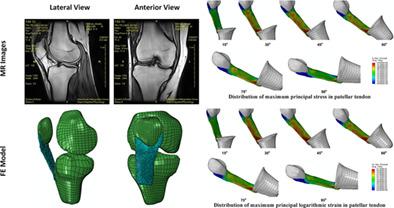当前位置:
X-MOL 学术
›
Int. J. Numer. Method. Biomed. Eng.
›
论文详情
Our official English website, www.x-mol.net, welcomes your
feedback! (Note: you will need to create a separate account there.)
A biomechanical analysis of 3D stress and strain patterns in patellar tendon during knee flexion.
International Journal for Numerical Methods in Biomedical Engineering ( IF 2.2 ) Pub Date : 2020-07-25 , DOI: 10.1002/cnm.3379 Kunyang Wang 1, 2 , Soroosh H Hosseinnejad 2 , Ali Jabran 2 , Vasilios Baltzopoulos 3 , Lei Ren 1, 2 , Zhihui Qian 1
International Journal for Numerical Methods in Biomedical Engineering ( IF 2.2 ) Pub Date : 2020-07-25 , DOI: 10.1002/cnm.3379 Kunyang Wang 1, 2 , Soroosh H Hosseinnejad 2 , Ali Jabran 2 , Vasilios Baltzopoulos 3 , Lei Ren 1, 2 , Zhihui Qian 1
Affiliation

|
Patellar tendinopathy is among the most widespread patellar tendon diseases in athletes that participate in activities involving running and jumping. Although their symptoms can be detected, especially at the inferior pole of the patella, their biomechanical cause remains unknown. In this study, a three‐dimensional finite element model of knee complex was developed to investigate principal stress and strain distributions in the patellar tendon during 0° to 90° knee flexion and slow and fast level‐ground walking. Results indicate that the patellar tendon is subjected to tensile stress and strains during all three activities. During flexion, its central proximal posterior region exhibited highest peak stress and strain, followed by central distal posterior, central distal anterior and central proximal anterior region. Similar trends and magnitudes were reported during slow and fast walking. The region with highest principal stresses and strains, central proximal anterior region, also corresponds to the most commonly reported patellar tendinopathy lesion site, suggesting that principal stress and strain are good indicators of lesion site location. Additional factors such as regional variations in material properties and frequency and duration of cyclic loading also need to be considered when determining the biomechanical aetiology of patellar tendinopathy.
中文翻译:

膝关节屈曲过程中髌腱 3D 应力和应变模式的生物力学分析。
髌腱病是参与跑步和跳跃活动的运动员中最普遍的髌腱疾病之一。尽管可以检测到他们的症状,特别是在髌骨下极,但他们的生物力学原因仍然未知。在这项研究中,开发了膝关节复合体的三维有限元模型,以研究在 0° 至 90° 膝关节屈曲和慢速和快速平地行走过程中髌腱的主要应力和应变分布。结果表明,在所有三种活动中,髌腱都受到拉伸应力和应变。在屈曲期间,其中央近端后部区域表现出最高的峰值应力和应变,其次是中央远端后部、中央远端前部和中央近端前部区域。在慢速和快速步行过程中报告了类似的趋势和幅度。具有最高主应力和应变的区域,即中央近端前部区域,也对应于最常报告的髌腱病病变部位,表明主要应力和应变是病变部位位置的良好指标。在确定髌腱病的生物力学病因时,还需要考虑其他因素,例如材料特性的区域变化以及循环负荷的频率和持续时间。
更新日期:2020-07-25
中文翻译:

膝关节屈曲过程中髌腱 3D 应力和应变模式的生物力学分析。
髌腱病是参与跑步和跳跃活动的运动员中最普遍的髌腱疾病之一。尽管可以检测到他们的症状,特别是在髌骨下极,但他们的生物力学原因仍然未知。在这项研究中,开发了膝关节复合体的三维有限元模型,以研究在 0° 至 90° 膝关节屈曲和慢速和快速平地行走过程中髌腱的主要应力和应变分布。结果表明,在所有三种活动中,髌腱都受到拉伸应力和应变。在屈曲期间,其中央近端后部区域表现出最高的峰值应力和应变,其次是中央远端后部、中央远端前部和中央近端前部区域。在慢速和快速步行过程中报告了类似的趋势和幅度。具有最高主应力和应变的区域,即中央近端前部区域,也对应于最常报告的髌腱病病变部位,表明主要应力和应变是病变部位位置的良好指标。在确定髌腱病的生物力学病因时,还需要考虑其他因素,例如材料特性的区域变化以及循环负荷的频率和持续时间。











































 京公网安备 11010802027423号
京公网安备 11010802027423号